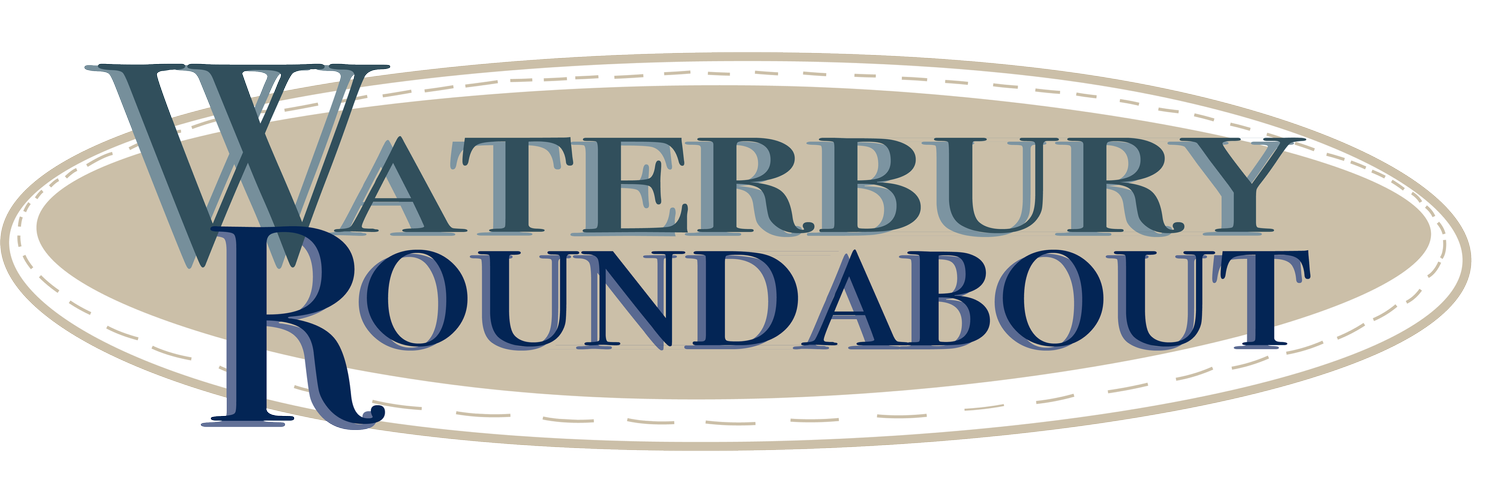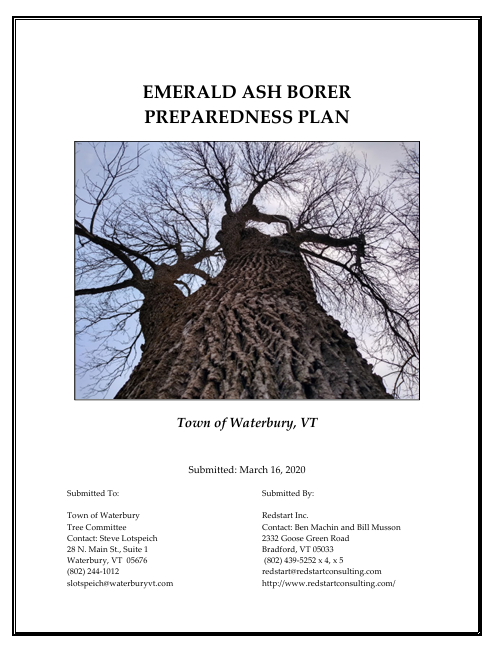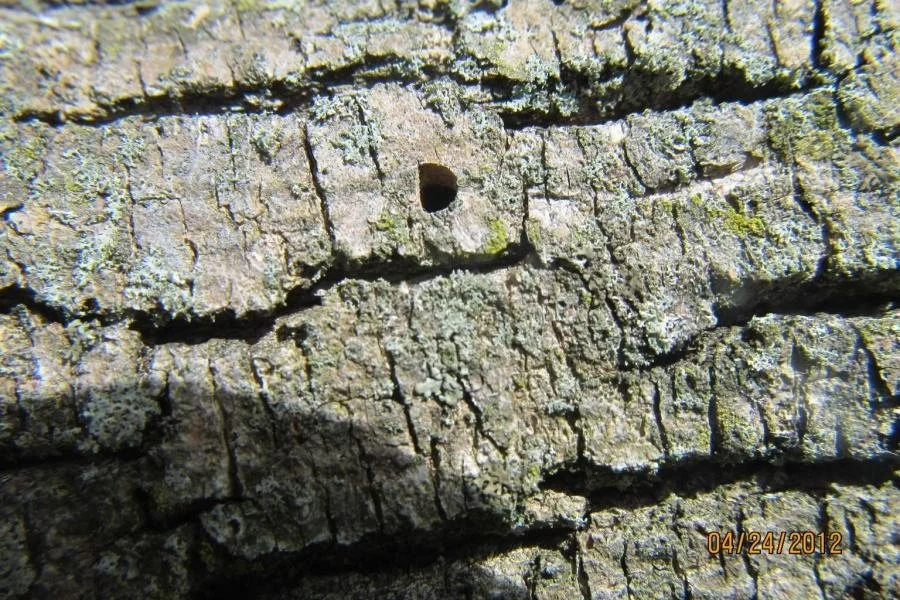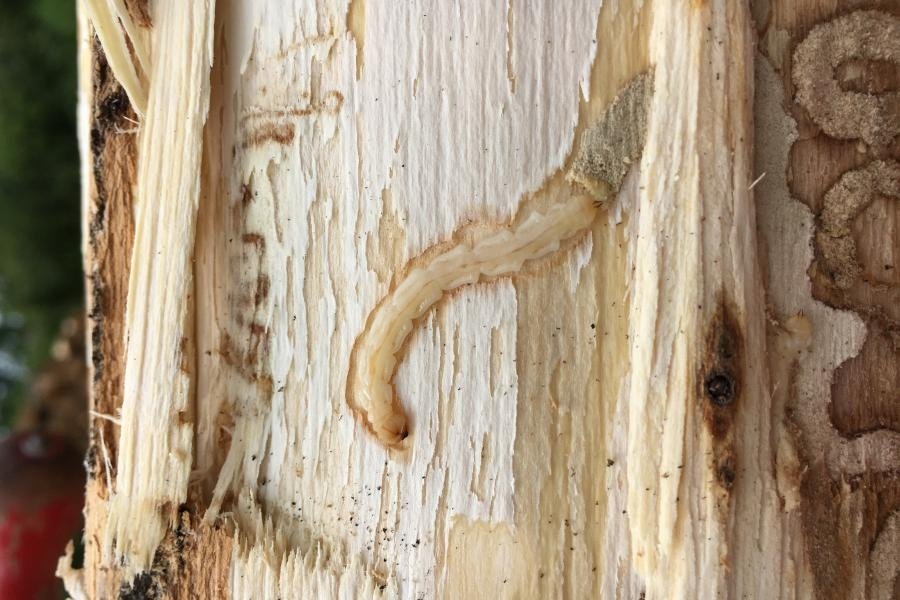Emerald ash borer found in two Waterbury trees
April 7, 2025 | By Sandy Yusen | CorrespondentAs foresters have warned since 2018, the inevitable arrival of the destructive emerald ash borer has been documented in Waterbury.
An adult emerald ash borer. VTInvasives.org photo
That was the news last week from Municipal Manager Tom Leitz to the Waterbury Select Board. Two trees in the town right-of-way along South Main Street have been confirmed to be infested with emerald ash borer.
The small iridescent-green insects – about an inch long and winged as adults – have been eating their way through North America’s ash trees for more than two decades.
Considered one of the most destructive invasive species in North America, the emerald ash borer is a wood-boring beetle that attacks and kills ash trees. The insect’s larvae feed on the inner wood of trees, cutting off water and nutrients. Native to Asia, the species was discovered in the U.S. in 2002, likely transported by shipping materials. It has since spread to 37 states and six Canadian provinces, destroying tens of millions of ash trees, according to the U.S. Department of Agriculture.
The invasive species was first identified in Vermont in Orange County in 2018, and is now found in 106 of Vermont’s 271 municipalities. The documented reports have been recorded in all counties except Essex County, according to state forestry experts.
Until recently, Waterbury was not on the ash borer list, although the first report in a town adjacent to Waterbury came last summer in Stowe. The spread of emerald ash borer is tracked on a website VTinvasives.org with maps and much information compiled by experts from the state, the University of Vermont and The Nature Conservancy. The maps so far show no ash borer infestation reports in the other communities that border Waterbury – Bolton, Duxbury, Middlesex and Moretown.
Leitz told the Waterbury Select Board that the two infested trees were identified at 148 and 137 South Main Street. The tree at 148 South Main was recently removed by Green Mountain Power, due to its close proximity to power lines. The tree at 137 South Main is expected to be taken down later this year, Leitz said.
An ash tree at 137 S. Main Street will be cut down due to emerald ash borer infestation. Photo by Sandy Yusen
The two infected ash trees were identified earlier this year, according to Jane Brown, who chairs the Waterbury Tree Board, a town-appointed advisory group that oversees the management of trees in the town’s public spaces.
“I did a walk in January with Jeff Spear from Acer Tree Co. of North and South Main Street to look at structural pruning for young trees that were planted as part of the Main Street Reconstruction,” Brown explained.
Spear expressed concerns about a few of the older trees and Brown arranged for a diagnosis by Adam McCullough of the state’s Vermont Urban and Community Forestry Program. McCullough inspected the trees and confirmed that they were infested with the emerald ash borer.
So far, the infestation appears to be early.
“The infested area does not appear to be widespread, and it is the only known population in Waterbury,” said Noah Hoffman, Invasive Species Coordinator for the Forestry Division of Vermont’s Department of Forests, Parks & Recreation. Hoffman serves on the Forest Health Team which has been tracking the spread of the emerald ash borer since it was first identified in Vermont.
Emerald ash borer planning
Anticipating the presence of this invasive pest, Waterbury town officials and the Tree Board have taken preemptive steps over the years to assess and manage the town’s ash population along roadways and in the town’s public spaces. The town conducted a downtown tree inventory in 2016, completed a roadside ash inventory in 2018 and 2019, and worked with a consultant to create an emerald ash borer preparedness plan in 2020 with grant support from the Vermont Department of Forests, Parks, and Recreation’s Urban & Community Forestry Program.
Waterbury’s Emerald Ash Borer Preparedness Plan is online here.
The preparedness plan identified 657 ash trees on town property in Waterbury, outlined options for managing the trees, and detailed the potential impact of the emerald ash borer on Waterbury, including the public safety risk of damaged or dead trees.
In the winter of 2020-21, the town received a $6,500 state grant to prepare for the emerald ash borer. Matched by the town, the funds paid for the removal of 15 ash trees in poor condition along Gregg Hill Road, Maggie’s Way and Shaw Mansion Road. The logs were split and sold as firewood, with proceeds benefiting the Waterbury Good Neighbor Fund and the Waterbury Rotary Club. Three healthy town-owned ash trees in Hope Cemetery and Hope Davey Park were inoculated with an insecticide to protect them from infestation and Evergreen Gardens was hired to plant a variety of trees other than ash in Hope Cemetery.
These steps followed the recommendations in the emerald ash borer preparedness plan, which includes a combination of proactive and reactive strategies for managing the town’s ash tree population. Reactive management involves removing ash trees once the infestation is identified. Proactive management combines removing ash trees before they are infested and inoculating healthy trees to protect them from infestation.
Both strategies have significant costs.
According to Leitz, the town’s 2025 tree budget is just $8,000. One mature tree being taken down can use about half that, he noted at last week’s Select Board meeting.
Protecting healthy trees through inoculation is also costly. “The inoculations to my knowledge are highly effective, but to inoculate a tree is a couple thousand dollars and you have to do it every other year. So it’s a very expensive proposition and, in all likelihood just due to financial pressures, it may be that we simply take down the ash trees as they get infected,” he said.
Signs of emerald ash borer activity
Click to enlarge photos below
Next steps
The Waterbury Tree Board is hosting a roundtable on April 18, from noon to 1:30 p.m. in the Steele Community Room at the Waterbury Municipal Center. This will be an opportunity for the Tree Board, town staff, and others including the public to discuss next steps for managing the town’s ash tree population given the now-documented arrival of emerald ash borer.
The trees within the town’s domain represent the tip of the iceberg compared to the tree population on private properties and forested areas in Waterbury. To help inform the broader public about the emerald ash borer and other invasive species, Hoffman’s Forest Health Team has a range of outreach and education efforts. “I would encourage local residents to learn more about identifying ash trees and the signs and symptoms of emerald ash borer, on private land as well as public areas in Waterbury,” Hoffman said.
To that end, the VTinvasives.org emerald ash borer website page has been set up to help Vermonters monitor and identify the emerald ash borer. The site is a joint effort between the University of Vermont Extension, the state Departments of Forests, Parks and Recreation and Environmental Conservation, and the Vermont Chapter of The Nature Conservancy. Visitors to the site can find a wealth of resources about invasive species, maps of infested areas, and recommendations to help stop the spread of pests. It also includes a reporting tool for people to report potential infestations. Hoffman said it can be challenging to identify the signs and symptoms of emerald ash borer activity.
“It’s a little bit tricky because the bugs are tiny and mostly live up in the canopy of the tree,” he explained. “It's very unusual to see an adult insect, so typically what you look for is a symptom of the tree's health.”
Warning signs include a thinning of the tree’s canopy in the upper branches, sprouting of small branches on the lower trunk, small D-shaped holes in the bark where the insects leave the tree, as well as signs of woodpecker foraging. In the later stages, ash borer larvae create tell-tale serpentine tunnels under the tree’s bark.
Green Mountain Power removed a tree infested with emerald ash borer at 148 S. Main St. recently. Photo by Sandy Yusen
A good first step for property owners, Hoffman advises, is to identify healthy ash trees that are not yet infested. “That can give you a chance to decide what you want to do about them – if you want to try to inoculate them and protect them, or if you want to remove them, and try to plant something else in its place,” he said.
The decision-making for private property owners is similar to what the town is grappling with. “It all costs money and it all takes work, but it costs less money and it takes less work the more you can plan in advance,” he said. “The fact that it's showing up there, means that I would stress a certain sense of urgency of finding out what's going on with the other trees in the town.”
As Leitz told select board members, “I think it’s safe to assume it will spread.”
An interactive map on the VTInvasives.org website shows towns in blue where emerald ash borer infestations have been reported. Screenshot






